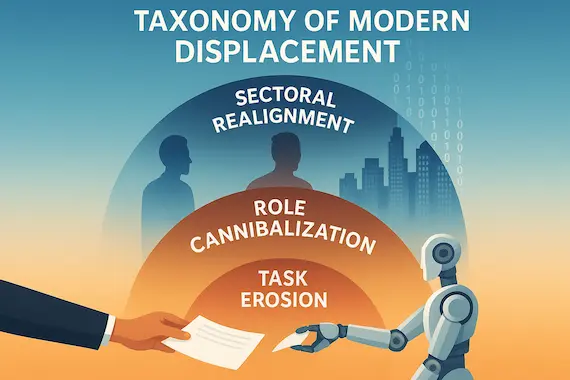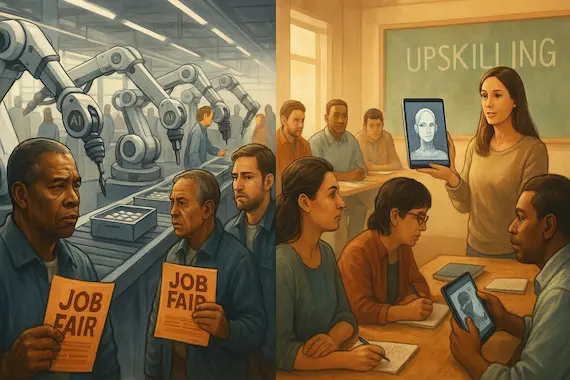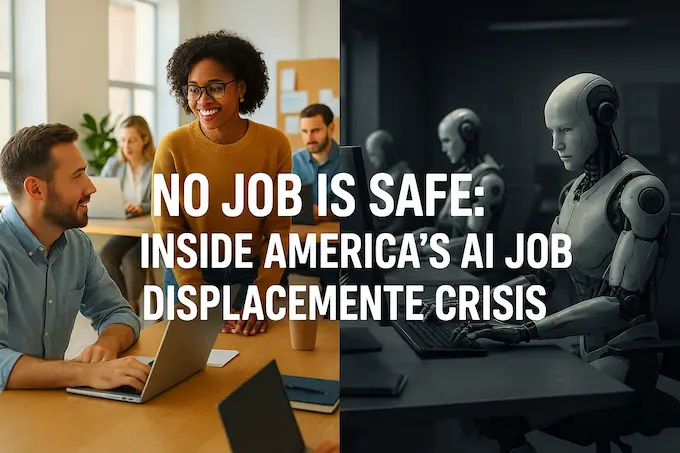Behind the Mask: How AI Deepfake Generators Power Misinformation
When a deepfake video falsely showed the author giving a public speech, it marked a turning point: AI deepfake generators now convincingly blur fact and fiction. This article investigates the rise of synthetic media, its use in political sabotage, multimillion-dollar frauds, and social engineering attacks targeting public figures and ordinary citizens alike.
It explains how these deepfakes are created—from image and voice data collection to face-swapping and post-processing—and explores cutting-edge detection tools like FaceForensics++ and Reality Defender. Readers are introduced to the most popular free and commercial AI deepfake tools, including DeepFaceLab, Synthesia, ElevenLabs, and Gemini Veo 2.
With laws and ethics racing to catch up, the article calls for stronger regulation and sharper public awareness. In a world where seeing is no longer believing, skepticism, digital literacy, and forensic vigilance are the last lines of defense against AI-driven deception.
AI Job Displacement: A Deep Dive into America’s Employment Crisis
The article explores the growing crisis of AI job displacement, tracing how artificial intelligence is not only replacing physical labor but increasingly eroding cognitive and creative work once deemed uniquely human. Unlike past automation waves, which primarily affected blue-collar jobs, today’s generative AI models are displacing roles in content creation, legal analysis, finance, and customer service.
What Is AI Job Displacement and Who Is at Risk?
Defined as the transfer of job tasks from humans to intelligent systems, AI job displacement now affects both low- and high-skilled roles. From call center agents replaced by chatbots to junior lawyers edged out by contract-analyzing algorithms, the impact of artificial intelligence on employment is both broad and profound. Even creative industries face AI job loss predictions, as algorithms generate publishable text and media with increasing quality.
AI Job Displacement Examples Across Industries
- Customer Service: AI handles basic queries, reducing headcount but increasing emotional load on remaining staff.
- Media & Content: Writers compete with bots that generate draft articles and social posts.
- Law & Finance: Automation of contract review and fraud detection leads to mass task offloading.
- Transport & Warehousing: Self-driving trucks and robotic logistics transform labor demand.
AI Job Displacement Statistics and Projections
- World Economic Forum (2025): 92 million jobs lost vs. 170 million created globally.
- McKinsey: 12 million Americans may need to switch careers by 2030.
- Goldman Sachs: 300 million jobs globally are “exposed” to AI, sparking headlines on how many jobs AI will replace by 2030.
These statistics on AI-induced job losses in the U.S. emphasize the urgency of preparing for job displacement due to technology.
AI Job Displacement vs Job Creation: Is There a Net Gain?
The article probes whether newly emerging jobs like “AI ethics auditor” or “prompt engineer” will be enough to absorb displaced workers. The answer: not without rapid retraining and inclusive policy. Otherwise, gains in one sector may be offset by losses in another, perpetuating inequality.
Negative Impact of Artificial Intelligence on Employment
The article doesn’t shy away from warning signs. Without intervention, automation can depress wages, deepen socioeconomic divides, and shrink middle-skill career paths. The mental toll of displacement—fear, instability, loss of purpose—is also highlighted.
Ways to Prevent AI Job Displacement Through Upskilling
- Accelerated reskilling programs at community colleges
- Portable benefits and wage insurance
- Transparent oversight of workplace AI tools
- Equity-sharing models to redistribute AI-driven gains
Conclusion
The crisis is real, but not inevitable. With smart policy, fast reskilling, and inclusive design, AI job displacement can become a catalyst for reinvention rather than ruin. The challenge is not just technological—it’s moral, economic, and political.
Introduction: Defining AI Job Displacement
I remember the exact moment the phrase AI job displacement stopped being an abstract headline and started feeling personal. A close friend—an ace copy editor—was handed a “productivity assistant” that drafted blurbs at lightning speed. Watching her rewrite the bot’s stiff sentences, I realized that replacement rarely arrives as a pink slip; it tip toes in as “helpful automation.” AI job displacement is, at its core, the gradual shifting of tasks—and eventually entire roles—from human hands to learning machines.
Unlike the factory robots of the 1980s that mainly threatened biceps and backs, today’s large language models muscle into cognition itself. Generative systems sift contracts, sketch legal briefs, even compose ironic tweets. The very cognitive territory many of us claim as uniquely ours is now contested. That expansion is why AI job displacement strikes white collar researchers, marketers, and paralegals as palpably as it does cashiers or forklift drivers.
Yet the story is nuanced. Early industrial automation reduced drudgery but grew overall employment in the long run. The question facing us in 2025 is whether the same virtuous cycle repeats—or whether the negative impact of artificial intelligence on employment swells beyond our historical playbook.
Table of Contents
A Quick Taxonomy of Modern Displacement
- Task erosion – A single duty (say, first pass document review) migrates to an algorithm while the broader role survives—at first.
- Role cannibalization – Accumulated task erosion eventually hollows out entire job descriptions, birthing full scale AI job loss predictions.
- Sectoral realignment – Whole industries re architect around new economics, producing fresh jobs even while torching the old ones—a tension we’ll revisit under “Displacement vs. Creation.”
So when we talk about AI job displacement, we’re not just tallying layoffs; we’re mapping a fluid border between human ingenuity and automated proficiency.
Geopolitical & Institutional Perspectives

Zoom out, and AI job displacement begins to look like a geopolitical chessboard. High income nations sit atop capital, compute, and data—fuel for rapid adoption—while lower income regions worry about export driven, routine jobs evaporating before new digital roles reach them.
- World Economic Forum frames the debate with sweeping scenarios: 92 million jobs potentially gone by 2030, 170 million created. Their “Reskilling Revolution” is less altruistic slogan and more survival blueprint.
- OECD analysts track the impact of artificial intelligence on employment across member states, highlighting that routine heavy occupations—clerks, machine operators—sit in the blast zone.
- IMF economists warn that productivity gains could pile disproportionately into capital returns, widening already yawning inequality.
In Washington, the Department of Labor quietly threads AI job displacement statistics into its forecasts, weighing tweaks to the WARN Act so that algorithm driven layoffs trigger earlier notice. Meanwhile, the European Union’s Artificial Intelligence Act labels workplace algorithms “high risk,” enforcing human in the loop audits. Each regulatory experiment is really a bet on how to steer job displacement due to technology without killing the innovation golden goose.
Industries Most Affected
Customer Service: From Hold Music to Machine Metrics
Ask anyone in a call center hub in Manila or Phoenix. Chatbots now answer tier one queries at scale, a textbook case of AI job displacement examples. Paradoxically, the volume of messy, emotionally charged calls is rising—humans still crave empathy. The result is Schrödinger’s workforce: fewer agents overall, but higher burnout for those who remain.
Content Creation & Media: Algorithms with By Lines
Generative models crank out sports recaps before the final whistle. The negative impact of artificial intelligence on employment here isn’t total erasure but a brutal compression of junior writer pipelines. Senior editors morph into curators of algorithmic drafts—if they adapt.
Law & Professional Services: Contracts at Machine Speed
JPMorgan’s COIN, which digests loan agreements in milliseconds, slashed 360,000 lawyer hours per year. That’s not a dystopian estimate; it’s last quarter’s reality. What is AI job displacement and who is at risk? In law, it’s the junior associate who once billed for finding boilerplate clauses.
Finance & Banking: Analysts vs. Algorithms
Quant desks already hum with code, but back office reconciliation, compliance checks, even risk modeling are entering machine territory. Goldman Sachs floats the figure of 300 million roles “exposed” globally—half a billion ears perk at that phrasing.
Transportation & Warehousing: The Long Haul to Autonomy
Self driving trucks lumber down Nevada test tracks while automated pickers zoom through Amazon shelves. McKinsey still predicts net logistics growth, yet drivers study ways to prevent AI job displacement through upskilling into fleet tech or drone maintenance.
Across these verticals, AI job displacement is uneven—sudden in some corners, glacial in others—but unmistakably present.
Projections of AI Driven Job Losses (2030)
Forecasting jobs is part statistical modeling, part clairvoyance. Still, it grounds the debate:
- World Economic Forum (2025): Net gain of 78 million roles worldwide, albeit amid 92 million losses.
- McKinsey & Company: Up to 12 million Americans may need a new occupation by 2030, effectively doubling recent churn rates.
- Goldman Sachs: Two thirds of U.S. jobs at least partially automatable, feeding headline grabbing AI job loss predictions.
Numbers vary, but the delta between creation and loss hinges on policy speed. The longer reskilling lags, the sharper the valley of AI job displacement becomes.
Displacement vs. Creation: New Roles Emerge

History offers a comforting pattern: telegraph operators vanish, network engineers rise. Will generative models repeat the trick? Evidence points both ways.
- Prompt engineer, AI ethics auditor, and data bias detective were unicorn titles in 2020; by 2025 they headline LinkedIn recruiting sprees.
- Healthtech needs imaging AI supervisors; agritech wants drone fleet agronomists.
These openings demonstrate AI job displacement vs job creation: Is there a net gain? Maybe, but only if transition pathways exist. Otherwise, creation blooms in one neighborhood while displacement scorches another.
Economic and Social Impact
Wages sit at the epicenter. Routine jobs—clerks, cashiers—show downward pressure, while data scientists see premiums. Economists label this a “barbell” market. Without guardrails, statistics on AI induced job losses in the U.S. could map neatly onto existing inequality fault lines: race, gender, geography.
Further, the psychological toll matters. During the last tech shift, displaced workers often pivoted into growth sectors within a generation. But how many jobs will AI replace by 2030 remains uncertain, and social media amplifies every layoff notice in real time, eroding worker confidence faster than the actual pink slips.
Expert Insights
- Yann LeCun quips that automating cognition is “adding skateboards under office chairs”—funny, but partial.
- Daron Acemoglu warns of a “so so automation” trap where productivity barely rises but jobs vanish—a grim form of AI job displacement that enriches no one.
- Andrej Karpathy, ever the pragmatist, reminds us that mastering new tools is part of the engineer’s contract with the future.
Their consensus: the technology is neutral; outcomes depend on socio technical choreography.
Responses from Labor and Regulators
Unions that once battled steam looms now haggle over algorithmic scheduling. The AFL CIO negotiates clauses granting workers veto power over invasive monitoring AI. Europe’s draft AI Act demands human oversight for hiring algorithms, while the White House nudges agencies to embed fairness checks.
These measures don’t halt AI job displacement; they civilize it—akin to building seatbelts rather than banning automobiles.
Opportunities: AI Augmented Roles
The flip side of disruption is augmentation. Surgeons guided by real time vision transformers perform feats that were sci fi a decade ago. Teachers armed with adaptive learning analytics tailor lessons, turning classrooms into micro studios of personalized education.
For individuals, the hack is simple: pair domain mastery with machine fluency. Whether you fix HVAC systems or orchestrate cloud microservices, sprinkle in model literacy and the odds of personal AI job displacement plummet.
Solutions and Recommendations
- Reskilling at warp speed
o Community colleges partnering with tech firms to deliver eight week ML ops bootcamps.
o Micro credentials recognized by employers—proof that “degrees” aren’t the sole passport past AI job displacement. - Robust safety nets
o Wage insurance that cushions income dips during retraining.
o Portable benefits so gig to full time transitions don’t annihilate healthcare coverage. - Transparency & oversight
o Mandatory algorithmic impact assessments, because you can’t fix what you can’t see.
o Worker councils with access to model documentation, aligning incentives. - Inclusive ownership
o Shared equity schemes: if an AI boosts productivity by 40%, a slice of that delta cycles back to staff—an antidote to the negative impact of artificial intelligence on employment narrative.
Each remedy chips away at the inevitability aura surrounding AI job displacement.
Conclusion
Standing at 2025’s crossroads, we confront a paradox. Never has the prospect of AI job displacement felt so daunting; never have we possessed such a toolkit for proactive adaptation. The arc of automation can bend toward shared prosperity—history shows it—but only with deliberate calibration.
So, where do we go when machines learn? We go back to learning ourselves, this time faster, broader, and with a dash more humility. We lobby for policies that treat humans as assets, not obsolete code. We embrace tools that enlarge our reach rather than shrink our worth.
If we do that, the phrase AI job displacement—repeated here more times than a neural network epoch—will shift from omen to case study, a chapter we navigate rather than a verdict we suffer.
Azmat — Founder of Binary Verse AI | Tech Explorer and Observer of the Machine Mind Revolution
For questions or feedback, feel free to contact us or explore our About Us page.
• Amazon’s warehouse robots and predictive tools cut inventory waste and reduced labor needs.
• Goldman Sachs uses AI for risk modeling and compliance, reducing analyst headcount.
• Wage insurance and portable benefits
• Reskilling subsidies and public-private training programs
• Mandatory algorithm audits
• Equity-sharing schemes for AI productivity gains
- McKinsey on Generative AI
- WEF Jobs Report 2025
- Goldman Sachs on AI
- OECD Employment Outlook
- Reuters on OECD AI Risk
- IMF Blog on AI
AI Job Displacement: The process by which artificial intelligence systems take over tasks or roles traditionally performed by humans, leading to reduced employment opportunities or transformed job functions.
AI Job Loss Predictions: Forecasts made by institutions estimating how many jobs will be lost due to AI by a specific year—commonly 2030.
Job Displacement Due to Technology: A broader term including job losses from all tech, including robotics and the internet.
Negative Impact of Artificial Intelligence on Employment: Includes job losses, wage suppression, increased inequality, and social instability.
The Impact of Artificial Intelligence on Employment: Neutral term covering both positive and negative employment effects of AI.
AI Job Displacement Statistics: Data showing how many jobs are or will be displaced by AI.
AI Job Displacement Examples: Real-world cases where AI has replaced or altered job functions.
AI Job Displacement vs Job Creation: A comparison of lost jobs vs new jobs created due to AI.
How Many Jobs Will AI Replace by 2030: Question answered by McKinsey, WEF, and others with specific job loss figures.
Ways to Prevent AI Job Displacement Through Upskilling: Strategies like bootcamps and certifications to adapt to AI-driven change.

